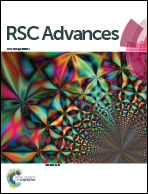Eclectic characterisation of chemically modified cell-derived matrices obtained by metabolic glycoengineering and re-assessment of commonly used methods†
Abstract
Azide-bearing cell-derived extracellular matrices (“clickECMs”) have emerged as a highly exciting new class of biomaterials. They conserve substantial characteristics of the natural extracellular matrix (ECM) and offer simultaneously small abiotic functional groups that enable bioorthogonal bioconjugation reactions. Despite their attractiveness, investigation of their biomolecular composition is very challenging due to the insoluble and highly complex nature of cell-derived matrices (CDMs). Yet, thorough qualitative and quantitative analysis of the overall material composition, organisation, localisation, and distribution of typical ECM-specific biomolecules is essential for consistent advancement of CDMs and the understanding of the prospective functions of the developed biomaterial. In this study, we evaluated frequently used methods for the analysis of complex CDMs. Sodium dodecyl sulphate polyacrylamide gel electrophoresis (SDS-PAGE) and (immune)histochemical staining methods in combination with several microscopic techniques were found to be highly eligible. Commercially available colorimetric protein assays turned out to deliver inaccurate information on CDMs. In contrast, we determined the nitrogen content of CDMs by elementary analysis and converted it into total protein content using conversion factors which were calculated from matching amino acid compositions. The amount of insoluble collagens was assessed based on the hydroxyproline content. The Sircol™ assay was identified as a suitable method to quantify soluble collagens while the Blyscan™ assay was found to be well-suited for the quantification of sulphated glycosaminoglycans (sGAGs). Eventually, we propose a series of suitable methods to reliably characterise the biomolecular composition of fibroblast-derived clickECM.



 Please wait while we load your content...
Please wait while we load your content...